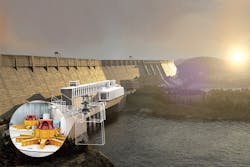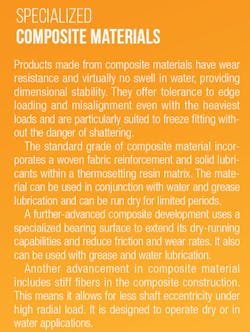As a major source of renewable energy, massive hydropower plants generate electricity around the world. Bearings keep turbines running smoothly, allowing the machines to operate effectively. A specialized composite bearing allows for advantages over traditional bearings when used in hydropower.
Hydropower, the generation of power from flowing water, is one of the most efficient forms of renewable energy and now provides about 16 percent of the world’s electricity.
Though today’s installations are on a huge scale, the power of water to create energy has been exploited since the time of the ancient Greeks. Kinetic energy of a flowing river has, for centuries, been used to turn water wheels, most commonly to grind wheat into flour.
Early hydropower
It was in the late 19th century that hydropower became a source of electricity. The first hydroelectric power plant was built at Niagara Falls, Canada, in 1879, and by 1881, street lamps in the city of Niagara Falls were powered by hydropower.
A typical hydro plant is a system with three parts: a plant where the electricity is produced; a dam that can be opened or closed to control water flow; and a reservoir where water is stored. The water behind the dam flows through an intake and pushes against blades in a turbine, causing them to turn. The turbine spins a generator to produce electricity.
The amount of electricity that can be generated depends on how far the water drops and how much water moves through the system. The electricity is then transported over long-distance electric lines.
Most-used composite material in bearings
One of the world’s largest hydro plants is the Three Gorges Dam on China’s Yangtze River. The biggest hydro plant in the U.S. is located at the Grand Coulee Dam on the Columbia River in northern Washington. A specialized composite bearing is installed in each of these plants. Composite bearing material is often used by the hydropower industry.
Composite bearings are "fish-friendly" since they can operate in dry-running applications and do not use harmful lubricants in the manufacturing process. Most metal bearings need grease to make them work properly, and during operation, this lubricant can enter the water, which is not environmentally friendly. The specialized composite bearing material offers excellent friction characteristics, meaning no grease is required.
Continued development
Although specialized composite bearing material has been manufactured since 1955, development continues in search of an even more advanced material portfolio for the hydropower industry.
A new composite bearing was recently introduced in the U.S. market to accommodate a need for higher load bearing applications while providing low-friction capabilities. Bearing requirements continue to change, and as they do, specialized composite bearings will evolve.
Tom Zozokos is product manager for Orkot Material from Trelleborg Sealing Solutions. Visit tss.trelleborg.com for more information.

